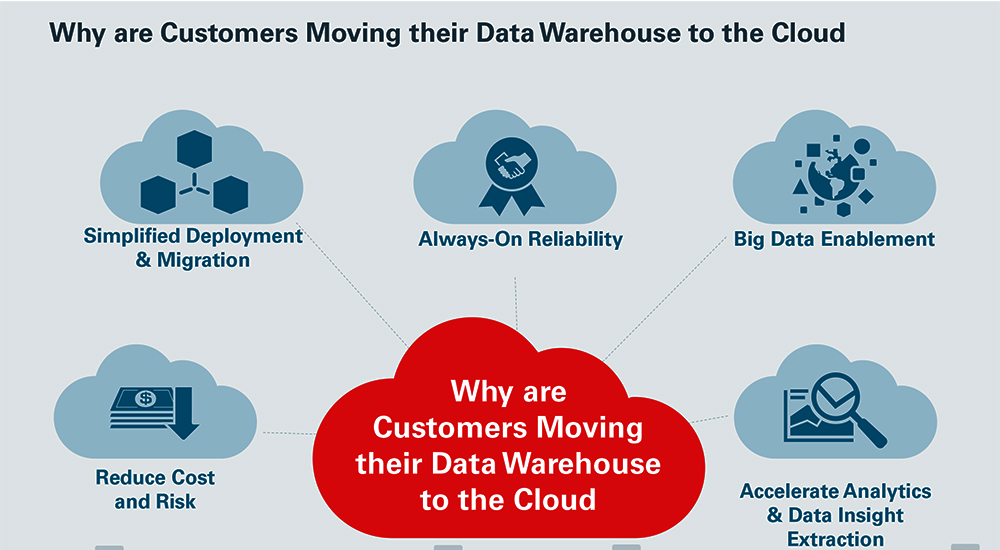Autonomous databases required for large scale business transformation

An autonomous database is a cloud database that uses machine learning to eliminate the human labor associated with database tuning, security, backups, updates, and other routine management tasks traditionally performed by database administrators .
Oracle Autonomous Database brings together decades of database automation, decades of automating database infrastructure, and new technology in the cloud to deliver a fully autonomous database. The Oracle Autonomous Database is self-driving, self-securing, and self-repairing. These features are meant to make Oracle Autonomous Database, amongst the simplest to use.
When Oracle started its journey to the cloud, it was a unique vision and unique strategy, according to Abdul Rahman Al Thehaiban, Senior Vice President Technology, MEA and CEE, Oracle. With Oracle end-users having made large investments on-premises, the migration to the public cloud was never expected to be overnight. “Customers really wants to go on cloud, but they cannot go to the cloud as plug and play because of past investments,” he explains.
Hence, Oracle developed all three cloud offerings – private cloud or on-premises, public cloud and hybrid cloud. Since then other global players such as Microsoft have also announced and launched their cloud strategies, prompting the recent tie up announcement from Oracle.
Microsoft and Oracle recently announced a cloud interoperability partnership agreement, enabling customers to migrate and run mission-critical enterprise workloads across Microsoft Azure and Oracle Cloud. Enterprises can now seamlessly connect Azure services, like analytics and AI, to Oracle Cloud services, like Autonomous Database.
“We believe our hybrid cloud strategy is a key differentiator of Oracle and that is why we have an alliance with Microsoft. We believe there are many Microsoft workloads that can capitalise on Oracle infrastructure”, says Al Thehaiban.
One of the important benefits of cloud is to enable business to become more agile. “The main driver to enter the cloud era is really to minimise the dependency on IT. At the end of the day, an organisation’s core strength core is their own competencies, not related to IT.”
Databases
Databases store critical business information and are essential for the efficient operation of modern organisations. If the database is not secure, the enterprise can be at risk of breaches. If the database is running slowly or is unavailable, employee productivity can suffer, and customers can be frustrated. Information stored in a database management system can be structured or the data can be unstructured. The data may be directly accessible by customers and employees or accessed indirectly through other enterprise software, websites, or mobile apps.
Examples of structured information stored in databases include: Accounting records, Customer information, Employee information, Maintenance records, Network traffic logs, Pricing information, Product inventory, Sales transactions, Social media interactions, Supply chain information.
Examples of unstructured information stored in databases: Digital images, sound, and video files, Programming source code, Spreadsheets, Website pages, Word-processing documents.
Business applications can add new records to existing databases or use database information to create reports, analyse trends, or look for anomalies. Databases can also grow to become Terabytes in size and are traditionally difficult for database administrators to manage, secure, and tune for maximum performance due to the database’s complexity.
Automation
- Autonomous database performs upgrades, installs patches, and tunes itself while running.
- Autonomous database should perform software patches and updates by itself.
- Security updates are installed with no downtime window required.
- Service-level agreements guarantee at least 99.995% reliability, availability, less than 30 minutes a year.
- Automated database tuning ensures database consumes fewer compute, memory, and IO resources.
Self-driving
Automates database and infrastructure management, monitoring, and tuning. This reduces the full-stack administration costs, although administrators will still be needed for tasks such as managing how applications connect to the data warehouse and how developers use the in-database features and functions without their application code.
Self-securing
Protects from both external attacks and malicious internal users, which means end users can stop worrying about cyberattacks on unpatched or unencrypted databases.
Self-repairing
Protects from downtime, including unplanned maintenance, with fewer than 2.5 minutes of downtime a month, including patching.

Database administrator
Enterprise databases are traditionally managed by database administrators, who create, modify, and tune databases to ensure maximum performance both when storing new data in a database, and then retrieving that data. Often, the process of retrieving data from a database is initiated through an application’s complex query. Running the query can consume a lot of compute and disk-access resources. The results can consist of many database records, which must be sent back to the querying application.
“The autonomous database is set to revolutionise data management, helping boost the speed of insight and driving significant increases in productivity whereby manpower can be optimised and resources can be deployed to higher value tasks,” adds Al Thehaiban.
One labor-intensive portion of the database administrator’s job is to organise the database so that frequently run queries can execute as quickly as possible, while consuming minimal resources. This requires studying the types of queries being run on the database and discerning patterns that will lead to improved tuning. Performance tuning is an ongoing part of database maintenance. A related task is data normalisation, which restructures data to reduce redundancy and improve data integrity.
The database administrator is responsible for other tasks, many of which must be executed on a daily or other regular basis on all enterprise databases, of which there could be dozens or hundreds. By some estimates, roughly 40% of database administrators today are managing 50 or more databases every day. Meanwhile, 78% of database administrators say they experience some type of unplanned downtime over the course of their careers, and most of these individuals struggle to coordinate multiple management and backup tools.
Meanwhile, 72% of IT budgets are spent simply maintaining existing information systems, leaving only 28% for innovation. Clearly, the need exists to reduce the effort needed to maintain databases, while also reducing downtime and improving performance.
Current workloads can lead to errors on the part of database administrators, and those errors can be catastrophic for uptime, performance, and security. For example, failing to apply a patch or security update can create vulnerabilities, but failing to apply the patch correctly can actually weaken or eliminate security protections. The errors seen in the news, where cloud databases are left unsecured by passwords or by encryption, and data was stolen by hackers, are almost always caused by human error.
An autonomous database has various benefits:
- Ensure uptime and performance
- Ensure security including patches and fixes
- Eliminate error-prone management through automation
- Allow human administrators perform higher level functions
By reducing the number of routine tasks performed by a database administrator who is working with an autonomous database, the organisation can refocus the database administrator’s efforts to higher-level work that creates greater business value. In some cases, an autonomous database can help the business save money by reducing the number of database administrators needed to manage its databases, or re-deploy them to a variety of tasks that are deemed more strategic.
Several fundamental technologies are necessary to implement autonomous databases, which can handle routine maintenance, scalability, security, database tuning, and other tasks without a human database administrator. This can be especially beneficial to developers.
Grow or shrink resources
A cloud-based database server can grow or shrink its compute and memory resources instantly, as needed. A customer could, for example, go from 8 cores of database computing to 16 cores to scale up for end-of-quarter processing, then back down to the less expensive 8 cores. One could even shut down all the compute resources over the weekend to reduce costs, and then start them up again on Monday morning.
Database patching
Many data break-ins happen through system vulnerabilities for which there was a security or vulnerability patch already available, but not yet applied. An autonomous database cloud will apply patches by rolling these patches against the servers in that cloud in a sequence designed to eliminate downtime for the business.
Machine learning
An autonomous database integrates monitoring, management, and analytics capabilities that leverage machine learning and artificial intelligence techniques. The goal is to automate database tuning, prevent application outages, and harden security across the entire database application.
Techniques used by the autonomous database’s machine learning and artificial intelligence algorithms should include query optimisation, automatic memory management, and automatic storage management to provide a completely self-tuning database.
Machine learning algorithms can help companies improve database security by analysing reams of logged data and flagging outliers and anomalous patterns before intruders can do damage. Machine learning can also automatically and continuously patch, tune, back up, and upgrade the system without manual intervention, all while the system is running. This minimizes the possibility that either human error or malicious behavior will affect database operations or security.

Autonomous data warehouse in the cloud
Autonomous database technology requires that enterprise databases be stored in the cloud, using a cloud service. Being autonomous in the cloud allows the organisation to leverage cloud resources to more effectively deploy databases, manage database workloads, and secure the database. A database cloud service makes database capabilities available online, when and where those capabilities are needed.
- Cloud database service advantages over legacy databases located in a customers’ data center include:
- Databases and data warehouses can be created in the cloud in mere minutes, instead of days or weeks.
- Cloud databases can be set up to be autonomous and accessed via APIs.
- Cloud databases can add compute and storage resources without downtime.
- Security in a cloud database locks out internal and external bad actors through multi-layered controls.
- Cloud database access is monitored and recorded for audit at all times.
Key takeaways
- 72% IT budgets spent maintaining existing information systems, leaving 28% for innovation.
- Need exists to reduce effort needed to maintain databases while reducing downtime.
- Current workloads can lead to errors and those errors can be catastrophic for uptime.
- Errors seen in news, are almost always caused by human error.
- Autonomous Database brings together decades of automating database infrastructure.
- Autonomous Database is self-driving, self-securing, and self-repairing.





